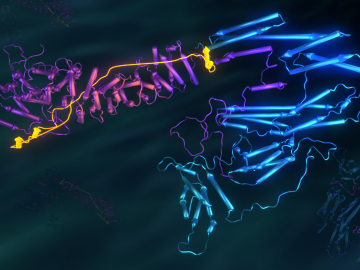
Filter News
Area of Research
- Advanced Manufacturing (6)
- Biology and Environment (14)
- Building Technologies (1)
- Computational Biology (1)
- Computational Engineering (2)
- Computer Science (12)
- Electricity and Smart Grid (1)
- Energy Science (37)
- Functional Materials for Energy (2)
- Fusion and Fission (9)
- Fusion Energy (7)
- Isotopes (3)
- Materials (53)
- Materials Characterization (2)
- Materials for Computing (11)
- Materials Under Extremes (1)
- Mathematics (1)
- National Security (7)
- Neutron Science (33)
- Nuclear Science and Technology (6)
- Quantum information Science (4)
- Supercomputing (31)
News Type
News Topics
- (-) Biomedical (18)
- (-) Computer Science (70)
- (-) Fusion (19)
- (-) Machine Learning (19)
- (-) Materials (70)
- (-) Neutron Science (42)
- (-) Physics (11)
- (-) Quantum Science (17)
- (-) Security (4)
- 3-D Printing/Advanced Manufacturing (57)
- Advanced Reactors (18)
- Artificial Intelligence (33)
- Big Data (26)
- Bioenergy (26)
- Biology (31)
- Biotechnology (6)
- Buildings (31)
- Chemical Sciences (31)
- Clean Water (14)
- Composites (16)
- Coronavirus (15)
- Critical Materials (13)
- Cybersecurity (9)
- Emergency (2)
- Energy Storage (50)
- Environment (67)
- Exascale Computing (11)
- Fossil Energy (1)
- Frontier (10)
- Grid (28)
- High-Performance Computing (33)
- Hydropower (6)
- Irradiation (3)
- Isotopes (15)
- ITER (5)
- Materials Science (54)
- Mathematics (3)
- Mercury (3)
- Microscopy (21)
- Molten Salt (6)
- Nanotechnology (25)
- National Security (13)
- Nuclear Energy (36)
- Partnerships (11)
- Polymers (15)
- Quantum Computing (9)
- Simulation (16)
- Software (1)
- Space Exploration (11)
- Statistics (1)
- Summit (11)
- Transportation (52)
Media Contacts

A novel approach developed by scientists at ORNL can scan massive datasets of large-scale satellite images to more accurately map infrastructure – such as buildings and roads – in hours versus days.

Oak Ridge National Laboratory will partner with Cincinnati Children’s Hospital Medical Center to explore ways to deploy expertise in health data science that could more quickly identify patients’ mental health risk factors and aid in

The prospect of simulating a fusion plasma is a step closer to reality thanks to a new computational tool developed by scientists in fusion physics, computer science and mathematics at ORNL.

To better determine the potential energy cost savings among connected homes, researchers at Oak Ridge National Laboratory developed a computer simulation to more accurately compare energy use on similar weather days.

As scientists study approaches to best sustain a fusion reactor, a team led by Oak Ridge National Laboratory investigated injecting shattered argon pellets into a super-hot plasma, when needed, to protect the reactor’s interior wall from high-energy runaway electrons.

Researchers at the Department of Energy’s Oak Ridge National Laboratory have received five 2019 R&D 100 Awards, increasing the lab’s total to 221 since the award’s inception in 1963.

Researchers used neutron scattering at Oak Ridge National Laboratory’s Spallation Neutron Source and High Flux Isotope Reactor to better understand how certain cells in human tissue bond together.

In collaboration with the Department of Veterans Affairs, a team at Oak Ridge National Laboratory has expanded a VA-developed predictive computing model to identify veterans at risk of suicide and sped it up to run 300 times faster, a gain that could profoundly affect the VA’s ability to reach susceptible veterans quickly.

Researchers used neutron scattering at Oak Ridge National Laboratory’s Spallation Neutron Source to probe the structure of a colorful new material that may pave the way for improved sensors and vivid displays.

Oak Ridge National Laboratory is training next-generation cameras called dynamic vision sensors, or DVS, to interpret live information—a capability that has applications in robotics and could improve autonomous vehicle sensing.


